Studies of the resonance structure in $D^{0} \to K^\mp \pi^\pm \pi^\pm \pi^\mp$ decays
[to restricted-access page]Information
LHCb-PAPER-2017-040
CERN-EP-2017-314
arXiv:1712.08609 [PDF]
(Submitted on 22 Dec 2017)
Eur. Phys. J. C78 (2018) 443
Inspire 1644791
Tools
Abstract
Amplitude models are constructed to describe the resonance structure of ${D^{0}\to K^{-}\pi^{+}\pi^{+}\pi^{-}}$ and ${D^{0} \to K^{+}\pi^{-}\pi^{-}\pi^{+}}$ decays using $pp$ collision data collected at centre-of-mass energies of 7 and 8 TeV with the LHCb experiment, corresponding to an integrated luminosity of $3.0\mathrm{fb}^{-1}$. The largest contributions to both decay amplitudes are found to come from axial resonances, with decay modes $D^{0} \to a_1(1260)^{+} K^{-}$ and $D^{0} \to K_1(1270/1400)^{+} \pi^{-}$ being prominent in ${D^{0}\to K^{-}\pi^{+}\pi^{+}\pi^{-}}$ and $D^{0}\to K^{+}\pi^{-}\pi^{-}\pi^{+}$, respectively. Precise measurements of the lineshape parameters and couplings of the $a_1(1260)^{+}$, $K_1(1270)^{-}$ and $K(1460)^{-}$ resonances are made, and a quasi model-independent study of the $K(1460)^{-}$ resonance is performed. The coherence factor of the decays is calculated from the amplitude models to be $R_{K3\pi} = 0.459\pm 0.010 (\mathrm{stat}) \pm 0.012 (\mathrm{syst}) \pm 0.020 (\mathrm{model})$, which is consistent with direct measurements. These models will be useful in future measurements of the unitary-triangle angle $\gamma$ and studies of charm mixing and $C P$ violation.
Figures and captions
|
Invariant mass and mass difference distributions for RS (top) and WS (bottom) samples, shown with fit projections. The signal region is indicated by the filled grey area, and for each plot the mass window in the orthogonal projection is applied. |
Fig1a.pdf [70 KiB] HiDef png [220 KiB] Thumbnail [177 KiB] *.C file |
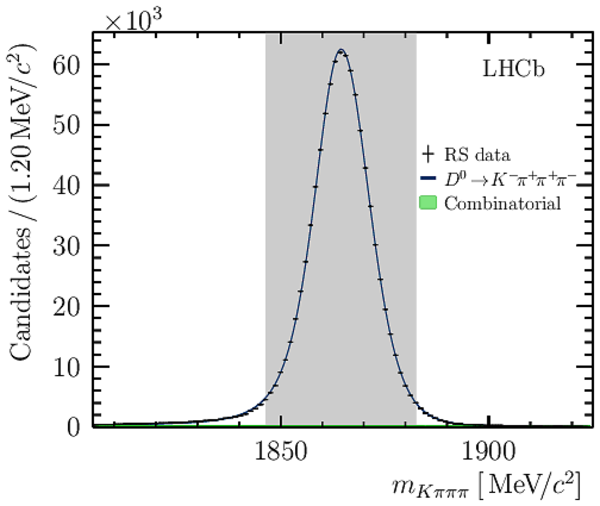
|
|
Fig1b.pdf [63 KiB] HiDef png [222 KiB] Thumbnail [176 KiB] *.C file |

|
|
|
Fig1c.pdf [72 KiB] HiDef png [281 KiB] Thumbnail [234 KiB] *.C file |
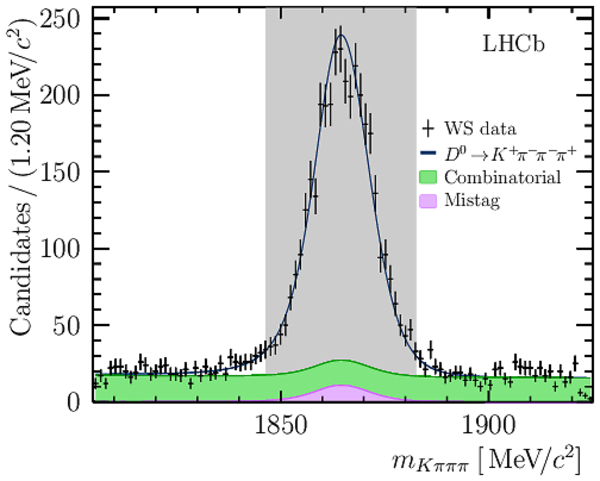
|
|
|
Fig1d.pdf [65 KiB] HiDef png [281 KiB] Thumbnail [218 KiB] *.C file |

|
|
|
Distributions for six invariant-mass observables in the RS decay $ D ^0 \rightarrow K ^- \pi ^+ \pi ^+ \pi ^- $ . Bands indicate the expectation from the model, with the width of the band indicating the total systematic uncertainty. The total background contribution, which is very low, is shown as a filled area. In figures that involve a single positively-charged pion, one of the two identical pions is selected randomly. |
Fig2a.pdf [76 KiB] HiDef png [243 KiB] Thumbnail [191 KiB] *.C file |
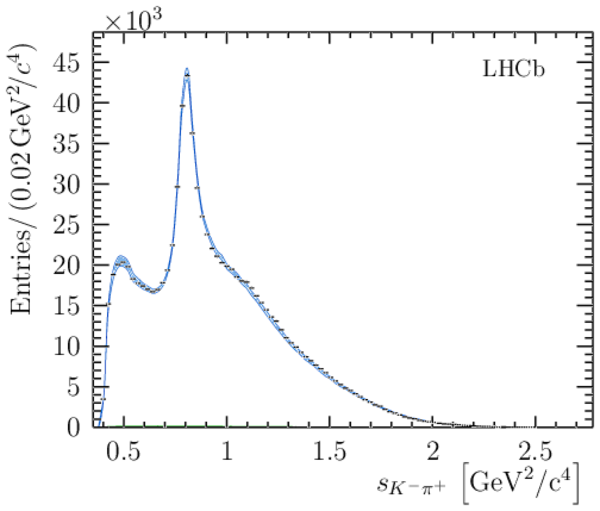
|
|
Fig2b.pdf [77 KiB] HiDef png [274 KiB] Thumbnail [216 KiB] *.C file |

|
|
|
Fig2c.pdf [73 KiB] HiDef png [215 KiB] Thumbnail [162 KiB] *.C file |

|
|
|
Fig2d.pdf [75 KiB] HiDef png [268 KiB] Thumbnail [201 KiB] *.C file |

|
|
|
Fig2e.pdf [74 KiB] HiDef png [247 KiB] Thumbnail [185 KiB] *.C file |
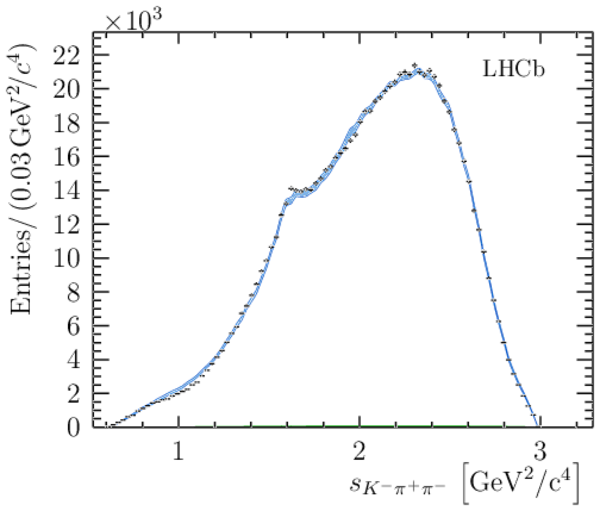
|
|
|
Fig2f.pdf [74 KiB] HiDef png [261 KiB] Thumbnail [194 KiB] *.C file |
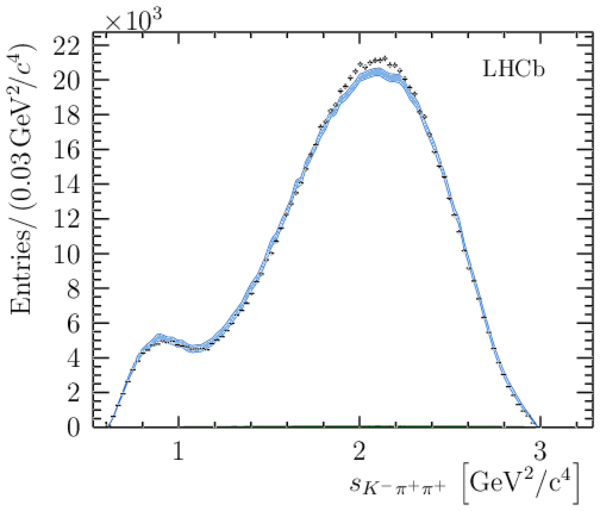
|
|
|
Argand diagram for the model-independent partial-wave analysis (MIPWA) for the $ K (1460)$ resonance. Points show the values of the amplitude that are determined by the fit, with only statistical uncertainties shown. |
Fig3.pdf [42 KiB] HiDef png [130 KiB] Thumbnail [75 KiB] *.C file |
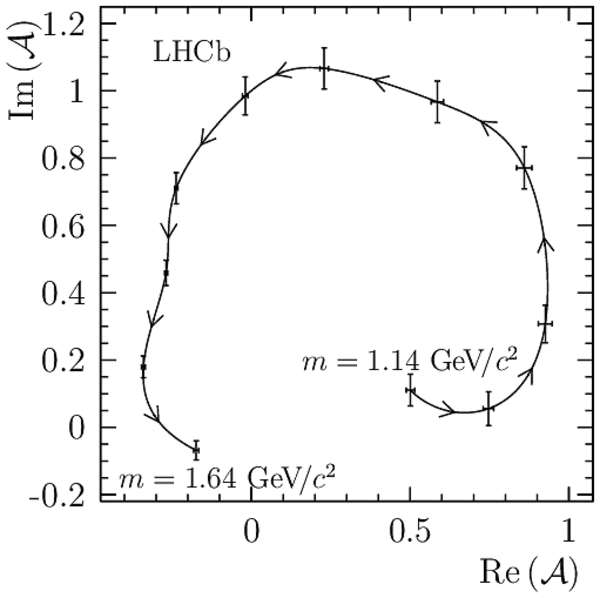
|
|
Parity violating distributions for the RS decay in the $\overline{ K }{} {}^* (892)^{0}\rho(770)^{0}$ region defined by $\pm 35 \mathrm{ Me V} $($\pm 100 \mathrm{ Me V} $) mass windows about the nominal $\overline{ K }{} {}^* (892)^{0}$ $(\rho(770)^{0})$ masses. Bands show the predictions of the fitted model including systematic uncertainties. |
Fig4a.pdf [61 KiB] HiDef png [400 KiB] Thumbnail [266 KiB] *.C file |
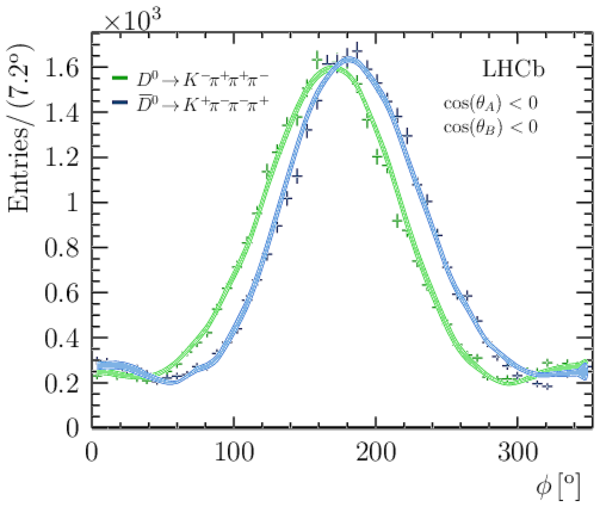
|
|
Fig4b.pdf [61 KiB] HiDef png [417 KiB] Thumbnail [278 KiB] *.C file |

|
|
|
Fig4c.pdf [60 KiB] HiDef png [405 KiB] Thumbnail [262 KiB] *.C file |
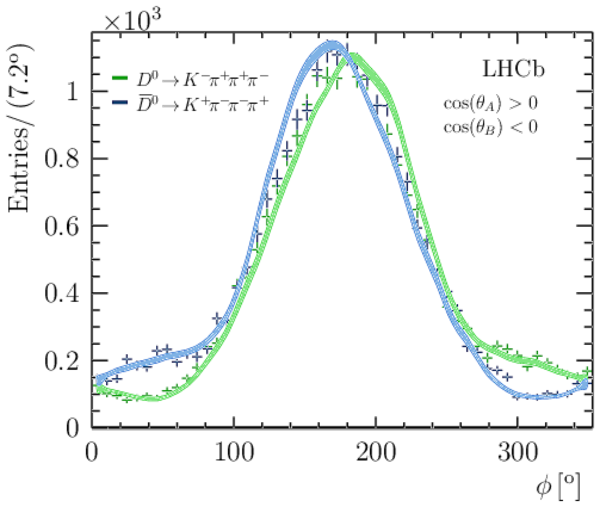
|
|
|
Fig4d.pdf [59 KiB] HiDef png [396 KiB] Thumbnail [269 KiB] *.C file |
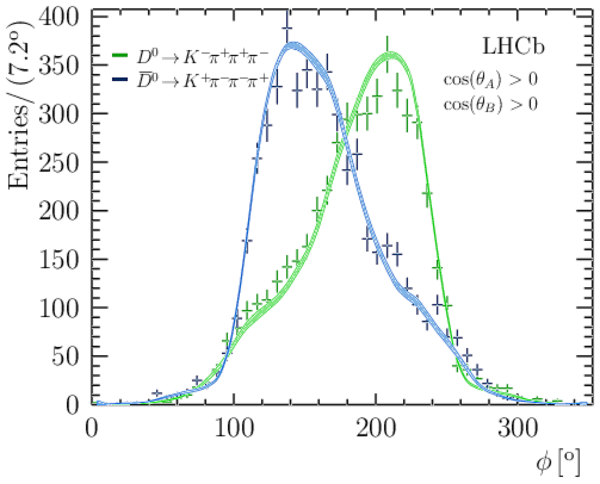
|
|
|
Distributions for six invariant-mass observables in the WS decay $ D ^0 \rightarrow K ^+ \pi ^- \pi ^- \pi ^+ $ . Bands indicate the expectation from the model, with the width of the band indicating the total systematic uncertainty. The total background contribution is shown as a filled area, with the lower region indicating the expected contribution from mistagged $\overline{ D }{} {}^0 \rightarrow K ^+ \pi ^- \pi ^- \pi ^+ $ decays. In figures that involve a single negatively-charged pion, one of the two identical pions is selected randomly. |
Fig5a.pdf [58 KiB] HiDef png [270 KiB] Thumbnail [195 KiB] *.C file |
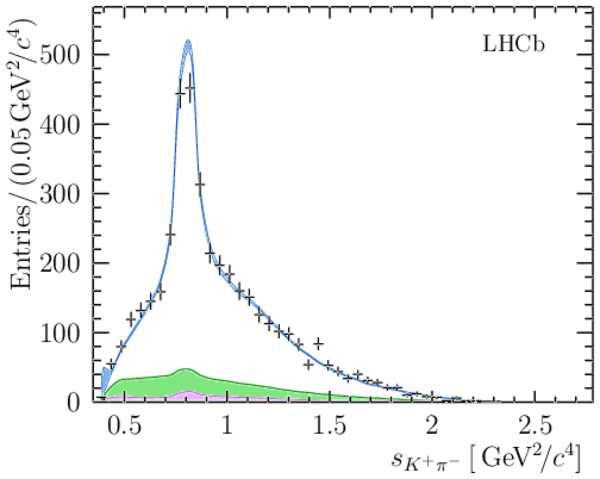
|
|
Fig5b.pdf [68 KiB] HiDef png [340 KiB] Thumbnail [260 KiB] *.C file |
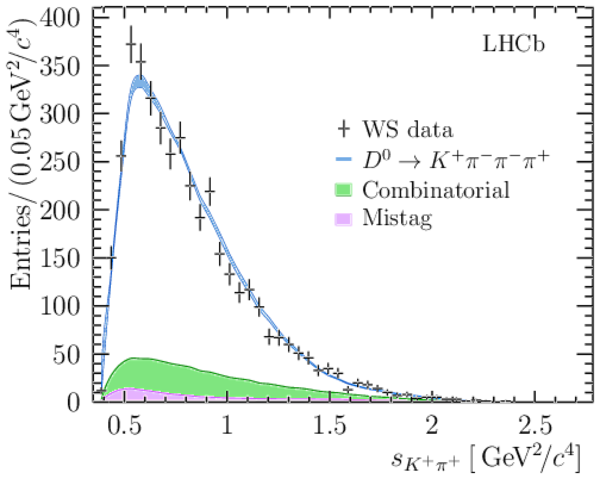
|
|
|
Fig5c.pdf [56 KiB] HiDef png [274 KiB] Thumbnail [195 KiB] *.C file |

|
|
|
Fig5d.pdf [58 KiB] HiDef png [334 KiB] Thumbnail [246 KiB] *.C file |
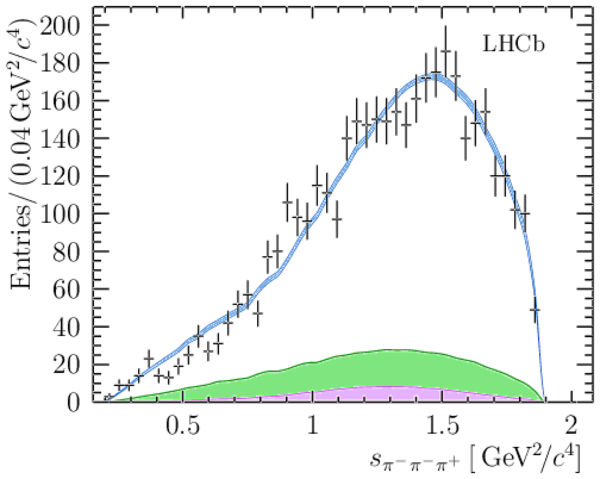
|
|
|
Fig5e.pdf [58 KiB] HiDef png [327 KiB] Thumbnail [238 KiB] *.C file |
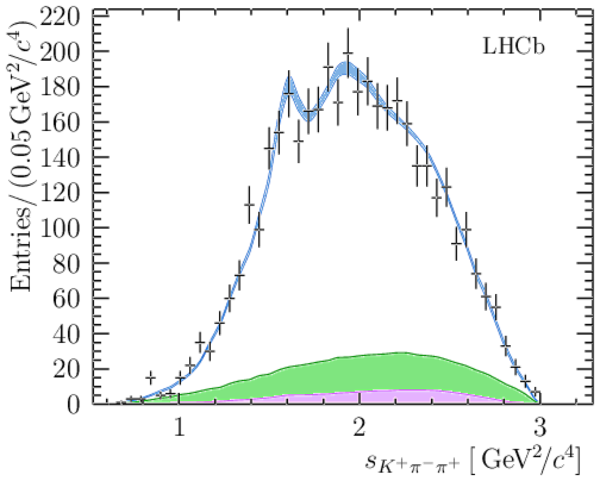
|
|
|
Fig5f.pdf [58 KiB] HiDef png [326 KiB] Thumbnail [240 KiB] *.C file |
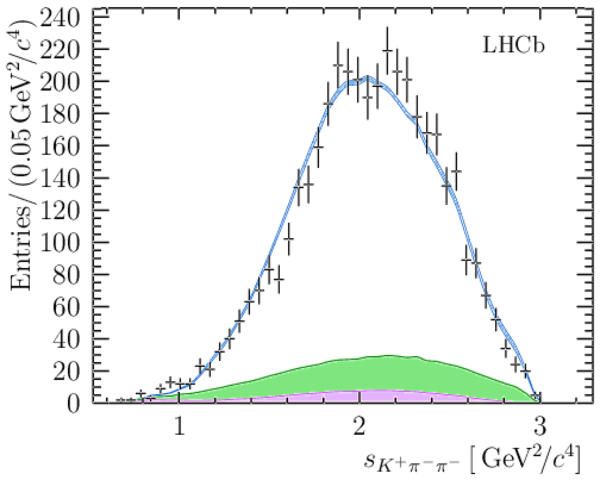
|
|
|
Distributions for six invariant-mass observables in the RS decay $ D ^0 \rightarrow K ^- \pi ^+ \pi ^+ \pi ^- $ . Bands indicate the expectation from a model which excludes the decay chain $K_1(1270)^{-}\rightarrow \rho(1450)^{0} K ^- $, with the width of the band indicating the total systematic uncertainty. The total background contribution, which is very low, is shown in green. |
Fig6a.pdf [76 KiB] HiDef png [251 KiB] Thumbnail [193 KiB] *.C file |
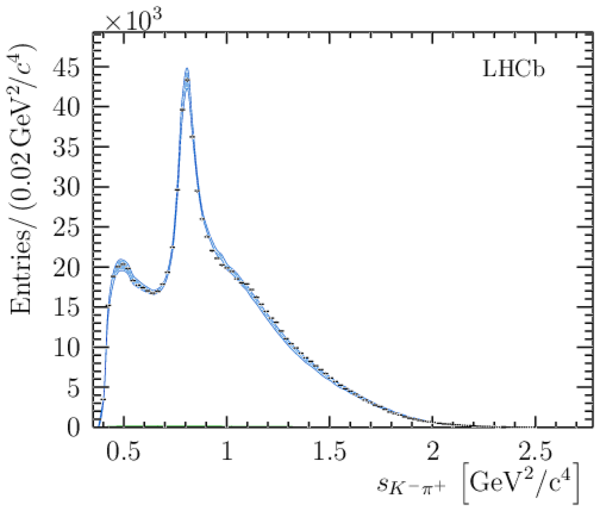
|
|
Fig6b.pdf [77 KiB] HiDef png [280 KiB] Thumbnail [219 KiB] *.C file |
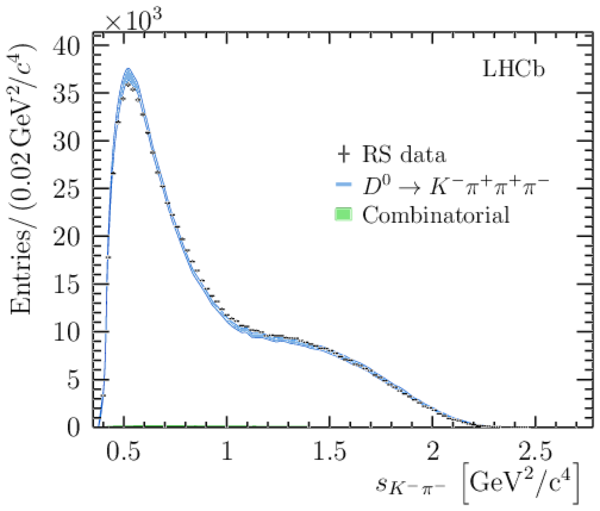
|
|
|
Fig6c.pdf [74 KiB] HiDef png [220 KiB] Thumbnail [164 KiB] *.C file |

|
|
|
Fig6d.pdf [75 KiB] HiDef png [276 KiB] Thumbnail [206 KiB] *.C file |
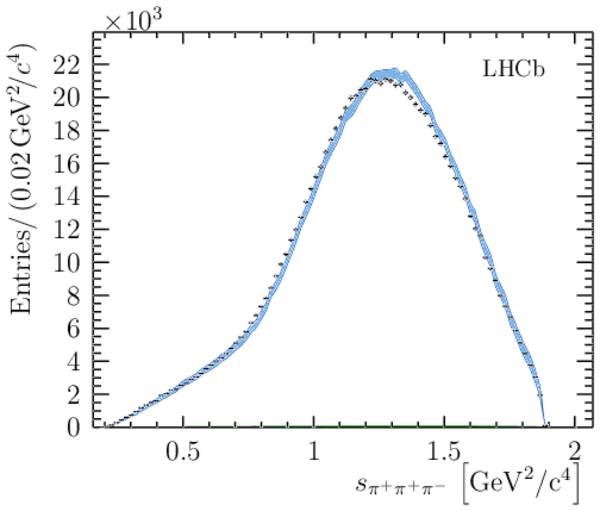
|
|
|
Fig6e.pdf [74 KiB] HiDef png [253 KiB] Thumbnail [189 KiB] *.C file |
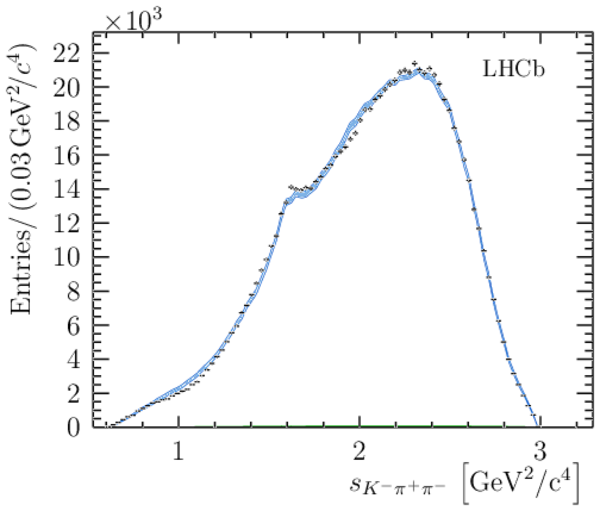
|
|
|
Fig6f.pdf [74 KiB] HiDef png [270 KiB] Thumbnail [198 KiB] *.C file |

|
|
|
Animated gif made out of all figures. |
PAPER-2017-040.gif Thumbnail |

|
Tables and captions
|
Signal and background yields for both samples in the signal region, presented separately for each year of data taking. |
Table_1.pdf [62 KiB] HiDef png [67 KiB] Thumbnail [33 KiB] tex code |

|
|
Fit fractions and coupling parameters for the RS decay $ D ^0 \rightarrow K ^- \pi ^+ \pi ^+ \pi ^- $ . For each parameter, the first uncertainty is statistical and the second systematic. Couplings $g$ are defined with respect to the coupling to the channel $ D ^0 \rightarrow[\overline{ K }{} {}^* (892)^{0}\rho(770)^{0}]^{L=2}$. Also given are the $\chi^2$ and the number of degrees of freedom ($\nu$) from the fit and their ratio. |
Table_2.pdf [87 KiB] HiDef png [185 KiB] Thumbnail [86 KiB] tex code |

|
|
Table of fit fractions and coupling parameters for the component involving the $ a_{1}(1260)^{+}$ meson, from the fit performed on the RS decay $ D ^0 \rightarrow K ^- \pi ^+ \pi ^+ \pi ^- $ . The coupling parameters are defined with respect to the $ a_{1}(1260)^{+} \rightarrow\rho(770)^{0}\pi ^+ $ coupling. For each parameter, the first uncertainty is statistical and the second systematic. |
Table_3.pdf [78 KiB] HiDef png [60 KiB] Thumbnail [28 KiB] tex code |

|
|
Table of fit fractions and coupling parameters for the component involving the $ K_{1}(1270) ^{-}$ meson, from the fit performed on the RS decay $ D ^0 \rightarrow K ^- \pi ^+ \pi ^+ \pi ^- $ . The coupling parameters are defined with respect to the $ K_{1}(1270) ^{-}\rightarrow\rho(770)^{0} K ^- $ coupling. For each parameter, the first uncertainty is statistical and the second systematic. |
Table_4.pdf [78 KiB] HiDef png [76 KiB] Thumbnail [35 KiB] tex code |

|
|
Table of fit fractions and coupling parameters for the component involving the $ K(1460)^{-}$ meson, from the fit performed on the RS decay $ D ^0 \rightarrow K ^- \pi ^+ \pi ^+ \pi ^- $ . The coupling parameters are defined with respect to the $ K(1460)^{-} \rightarrow\overline{ K }{} {}^* (892)^{0}\pi ^- $ coupling. For each parameter, the first uncertainty is statistical and the second systematic. |
Table_5.pdf [71 KiB] HiDef png [52 KiB] Thumbnail [24 KiB] tex code |

|
|
Fit fractions and coupling parameters for the WS decay $ D ^0 \rightarrow K ^+ \pi ^- \pi ^- \pi ^+ $ . For each parameter, the first uncertainty is statistical and the second systematic. Couplings $g$ are defined with respect to the coupling to the decay $ D ^0 \rightarrow[ K ^{*}(892)^{0}\rho(770)^{0}]^{L=2}$. Also given are the $\chi^2$ and the number of degrees of freedom ($\nu$) from the fit and their ratio. |
Table_6.pdf [79 KiB] HiDef png [99 KiB] Thumbnail [46 KiB] tex code |

|
|
Decay chains taken into account in alternative parametrisations of the RS decay mode ${ D ^0 \rightarrow K ^- \pi ^+ \pi ^+ \pi ^- }$. For each chain, the fraction of models in the ensemble that contain this decay, together with the associated average fit fraction, $\langle \mathcal{F} \rangle$, are shown. Components are not tabulated if they contribute to all models in the ensemble, or if they contribute to less than 5% of the models. |
Table_7.pdf [77 KiB] HiDef png [157 KiB] Thumbnail [79 KiB] tex code |

|
|
Dependence of fit fractions (and partial fractions) on the choice of the RS model. This dependence is expressed as the mean value and the RMS of the values in the ensemble. Also shown is the fit fractions of the baseline model presented in Sect. 6.2. |
Table_8.pdf [78 KiB] HiDef png [275 KiB] Thumbnail [138 KiB] tex code |

|
|
Dependence of the fitted masses and widths on the final choice of the RS model. This dependence is expressed as the mean value and the RMS of the values in the ensemble. The values found for the baseline model presented in Sect. 6.2 are reported for comparison. |
Table_9.pdf [61 KiB] HiDef png [88 KiB] Thumbnail [43 KiB] tex code |

|
|
Decay chains taken into account in alternative parametrisations of the WS decay mode ${ D ^0 \rightarrow K ^+ \pi ^- \pi ^- \pi ^+ }$. For each chain, the fraction of models in the ensemble that contain this decay, together with the associated average fit fraction, $\langle \mathcal{F} \rangle$, are shown. Components are not tabulated if they contribute to all models in the ensemble, or if they contribute to less than 5% of the models. |
Table_10.pdf [78 KiB] HiDef png [159 KiB] Thumbnail [80 KiB] tex code |

|
|
Coherence factor and average strong-phase differences in regions of phase space. The spread of coherence factors, average strong-phase difference and ratio of amplitudes from choice of WS model characterised with the RMS of the distribution. |
Table_11.pdf [66 KiB] HiDef png [118 KiB] Thumbnail [60 KiB] tex code |

|
|
Rules for calculating the current associated with a given decay chain in terms of the currents of the decay products. Where relevant, the spin projection operator $\mathcal{S}$ and the orbital angular momentum operators $L$ are those for the decaying particle. |
Table_12.pdf [73 KiB] HiDef png [139 KiB] Thumbnail [66 KiB] tex code |

|
|
Legend for systematic uncertainties, including whether this sources of uncertainty is considered on the RS/WS decay mode. |
Table_13.pdf [40 KiB] HiDef png [84 KiB] Thumbnail [37 KiB] tex code |

|
|
Systematic uncertainties on the RS decay coupling parameters and fit fractions for quasi two-body decay chains. |
Table_14.pdf [85 KiB] HiDef png [283 KiB] Thumbnail [132 KiB] tex code |

|
|
Systematic uncertainties on the RS decay coupling parameters, fit fractions and masses and widths of resonances for cascade topology decay chains. |
Table_15.pdf [80 KiB] HiDef png [416 KiB] Thumbnail [178 KiB] tex code |

|
|
Systematic uncertainties on the WS decay coupling parameters and fit fractions. |
Table_16.pdf [77 KiB] HiDef png [193 KiB] Thumbnail [84 KiB] tex code |

|
|
Interference fractions for the RS mode $ D ^0 \rightarrow K ^- \pi ^+ \pi ^+ \pi ^- $ , only shown for fractions $>0.5\%$. For each fraction, the first uncertainty is statistical and the second systematic. |
Table_17.pdf [77 KiB] HiDef png [175 KiB] Thumbnail [82 KiB] tex code |

|
|
Interference fractions for the WS mode $ D ^0 \rightarrow K ^+ \pi ^- \pi ^- \pi ^+ $ , only shown for fractions $>0.5\%$. For each fraction, the first uncertainty is statistical and the second systematic. |
Table_18.pdf [76 KiB] HiDef png [129 KiB] Thumbnail [60 KiB] tex code |

|
|
Table of fit fractions and coupling parameters and other quantities for the RS decay $ D ^0 \rightarrow K ^- \pi ^+ \pi ^+ \pi ^- $ , for a model excluding the decay chain $K_1(1270)^{-}\rightarrow \rho(1450)^0 K ^- $. Also given is the $\chi^2$ per degree of freedom ($\nu$) for the fit. The first uncertainty is statistical and the second systematic. Couplings are defined with respect to the coupling to the channel $ D ^0 \rightarrow[\overline{ K }{} {}^* (892)^{0}\rho(770)^{0}]^{L=2}$. |
Table_19.pdf [87 KiB] HiDef png [184 KiB] Thumbnail [86 KiB] tex code |

|
|
Table of fit fractions and coupling parameters for the component involving the $ a_{1}(1260)^{+}$ meson, from the fit performed on the RS decay $ D ^0 \rightarrow K ^- \pi ^+ \pi ^+ \pi ^- $ . The coupling parameters are defined with respect to the $ a_{1}(1260)^{+} \rightarrow\rho(770)^{0}\pi ^+ $ coupling. For each parameter, the first uncertainty is statistical and the second systematic. |
Table_20.pdf [78 KiB] HiDef png [60 KiB] Thumbnail [28 KiB] tex code |

|
|
Table of fit fractions and coupling parameters for the component involving the $ K_{1}(1270) ^{-}$ meson, from the fit performed on the RS decay $ D ^0 \rightarrow K ^- \pi ^+ \pi ^+ \pi ^- $ . The coupling parameters are defined with respect to the $ K_{1}(1270) ^{-}\rightarrow\rho(770)^{0} K ^- $ coupling. For each parameter, the first uncertainty is statistical and the second systematic. |
Table_21.pdf [78 KiB] HiDef png [65 KiB] Thumbnail [30 KiB] tex code |

|
|
Table of fit fractions and coupling parameters for the component involving the $ K(1460)^{-}$ meson, from the fit performed on the RS decay $ D ^0 \rightarrow K ^- \pi ^+ \pi ^+ \pi ^- $ . The coupling parameters are defined with respect to the $ K(1460)^{-} \rightarrow\overline{ K }{} {}^* (892)^{0}\pi ^- $ coupling. For each parameter, the first uncertainty is statistical and the second systematic. |
Table_22.pdf [71 KiB] HiDef png [51 KiB] Thumbnail [24 KiB] tex code |

|
Created on 20 April 2024.
